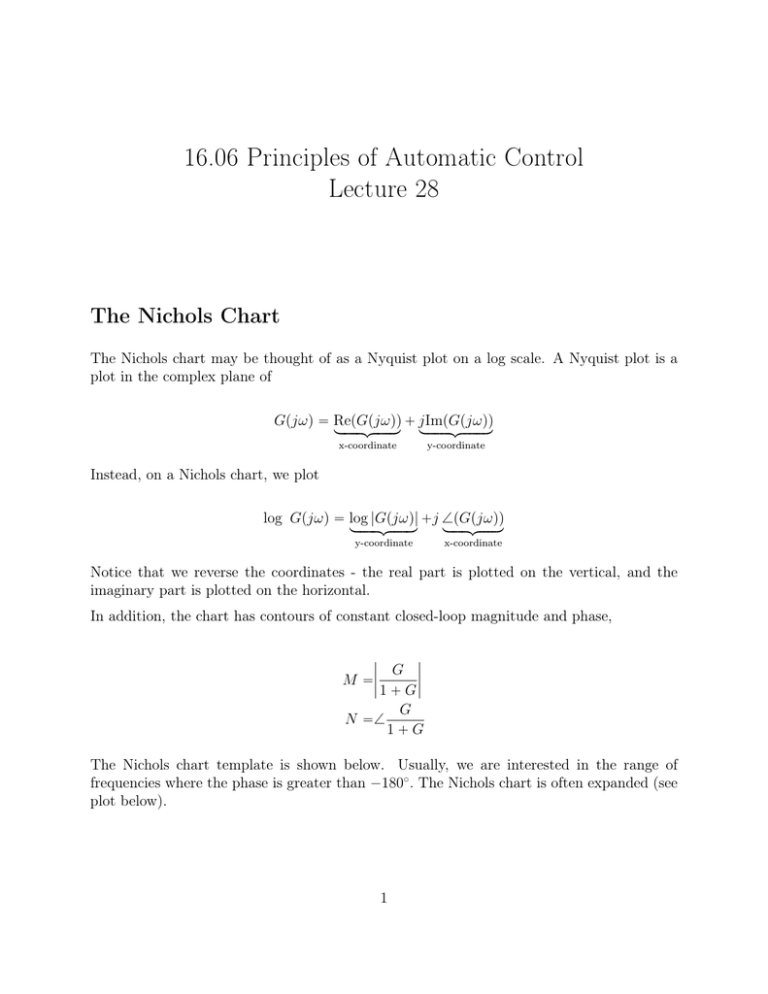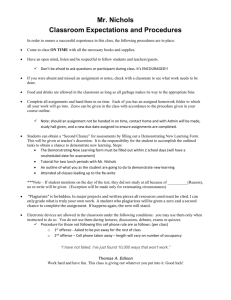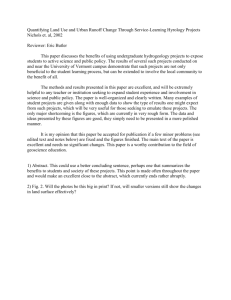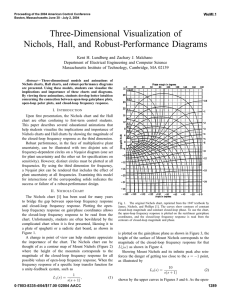Document 13352596
advertisement

16.06 Principles of Automatic Control
Lecture 28
The Nichols Chart
The Nichols chart may be thought of as a Nyquist plot on a log scale. A Nyquist plot is a
plot in the complex plane of
Gpjωq “ RepGpjωqq
looooomooooon ` jImpGpjωqq
looooomooooon
x-coordinate
y-coordinate
Instead, on a Nichols chart, we plot
log Gpjωq “ log
|Gpjωq| `j =pGpjωqq
looooomooooon
loooomoooon
y-coordinate
x-coordinate
Notice that we reverse the coordinates - the real part is plotted on the vertical, and the
imaginary part is plotted on the horizontal.
In addition, the chart has contours of constant closed-loop magnitude and phase,
ˇ
ˇ
ˇ G ˇ
ˇ
ˇ
M “ˇ
1 ` Gˇ
N “=
G
1`G
The Nichols chart template is shown below. Usually, we are interested in the range of
frequencies where the phase is greater than ´180˝ . The Nichols chart is often expanded (see
plot below).
1
30
25
20
15
−2
−5
1 dB
Magnitude, dB
10
0 dB
−10
−1 dB
2 dB
3 dB
5 dB
6 dB
−340
5
−2 dB
−20
4 dB
−350
−330
−3 dB
−30
9 dB
−4 dB
12 dB
−5 dB
−300
0
−6 dB
−60
−270
−90
−5
−240
−120
−210 −180 −150
−9 dB
−10
−12 dB
−15 dB
−15
−20
−360
−20 dB
−315
−270
−225
−180
−135
Phase, deg
2
−90
−45
0
30
25
20
15
−2
−5
0 dB
1 dB
Magnitude, dB
10
−10
−1 dB
2 dB
3 dB
5 dB
6 dB
−340
5
−2 dB
−20
4 dB
−350
−330
−3 dB
−30
9 dB
−4 dB
12 dB
−5 dB
−300
0
−6 dB
−60
−270
−90
−5
−240
−120
−210
−180
−150
−9 dB
−10
−12 dB
−15 dB
−15
−20
−225
−20 dB
−180
−135
−90
Phase, deg
3
−45
0
The Nichols chart was once very useful, since computers were not available to do the kids of
calculations that are now done by e.g., Matlab.
However, Nichols chart may be used to give insight into the closed-loop behavior of systems.
Consider first the system
+
r
G1
-
where
?
G1 “
2 10
sp1 ` s{10q
which has ωc “ 10 r/s, P M “ 45˝ .
Bode of G1 :
5
Magnitude of G
1
10
-1
10
0
-2
10
−5
10
−1
10
0
10
1
ω
10
2
10
3
Phase, degrees
0
−50
−100
−150
−200 −1
10
10
0
10
ω
1
10
2
10
3
The Nichols plot can be made by lifting points of the Bode plot, at individual frequencies,
and plotting on the Nichols chart. See plot below for the plot of G1 :
4
30
25
20
15
−2
−5
0 dB
1 dB
10
−10
−1 dB
2 dB
Magnitude, dB
3 dB
5 dB
6 dB
−340
5
−2 dB
−20
4 dB
−350
−330
−3 dB
−30
9 dB
−4 dB
12 dB
ωr=9.57, Mr=1.31 (2.4 dB)
ωc=10
−5 dB
−300
0
−6 dB
−60
−270
−90
−5
−240
−120
−210
−180
−150
−9 dB
−10
−12 dB
−15 dB
−15
−20
−225
−20 dB
−180
−135
−90
Phase, deg
−45
0
Note that ωr « ωc , so the peak in the frequency response (CL) is very close to crossover.
Note also that
Mp “ 0.23
5
For PM “ 45˝ , we expect
ζ “0.45
ñ Mp “0.21
Mr “1.24
In pretty good agreement with the actual results.
Now consider the plant
100 1 ` s{10
G2 “ ?
s2
2
in a similar unity feedback control. For this system, we have
PM “ 45˝ , ωc “ 10 r/s, also.
Bode plot:
5
Magnitude of G
1
10
10
10
0
−5
10
−1
10
0
10
1
10
2
10
3
Phase, degrees
0
−50
−100
−150
−200 −1
10
10
0
10
ω
6
1
10
2
10
3
Since the crossover and phase margin are the same, we expect to get similar performance.
Do we?
One clue can be seen in the Nichols chart, below.
30
25
20
15
−2
−5
0 dB
1 dB
Magnitude, dB
10
−10
−1 dB
2 dB
3 dB
5 dB
6 dB
−340
5
−2 dB
−20
4 dB
−350
−330
−3 dB
ωr=7.44, Mr=1.61 (4.1 dB)
−30
9 dB
−4 dB
12 dB
−300
−5 dB
ωc=10
0
−6 dB
−60
−270
−90
−5
−240
−120
−210
−180
−150
−9 dB
−10
−12 dB
−15 dB
−15
−20
−225
−20 dB
−180
−135
−90
Phase, deg
−45
0
Note that, in this case, ωr is significantly smaller than ωc , and Mr is larger than might be
7
expected from the PM. So we would expect that the closed-loop system
T2 “
G2
1 ` G2
would be a bit slower, and have more overshoot, than the system
T1 “
G1
1 ` G1
even though they have the same PM and ωc .
In fact, this is the case, as seen from the step responses below.
1.6
1.4
y2(t) Mp=0.34
Step Response
1.2
1
0.8
y1(t) Mp=0.23
0.6
0.4
0.2
0
0
0.5
1
Time, t (sec)
1.5
2
Counting Encirclements on a Nichols Chart
Counting encirclements on a Nichols chart can be tricky, because
1. The ´1{k point can be on either the ´180˝ line or the 0˝ line.
2. CW and CCW are reversed, because the orientation of the axes is reversed.
Will demonstrate with examples.
8
Example 1.
Gpsq “ 3000
s ´ 0.1
ps ´ 1qps ´ 2qps ` 10q2
Nyquist and Nichols plots are shown below.
Nyquist Diagram
5
4
3
Imaginary Axis
2
N=+1
1
N=-2
0
N=0
−1
−2
−3
−4
−5
−10
−9
−8
−7
−6
−5
Real Axis
9
−4
−3
−2
−1
0
Nichols Chart
19 dB
N=-2
20
N=0
6.27 dB
Open−Loop Gain (dB)
0
3.52 dB
−20
N=+1
−40
−60
−80
−100
−270
−225
−180
−135
−90
Open−Loop Phase (deg)
Example 2.
Gpsq “
-10
1 ps ` 0.1q2
s3 ps ` 10q2
-.1
Nichols chart is shown below. Note that care must be used to properly close contour near
ω “ 0.
10
Nichols Chart
100
N=2
Open−Loop Gain (dB)
50
0
N=1
N=0
−50
−100
N=2
−150
−200
−360 −315 −270 −225 −180 −135 −90
Open−Loop Phase (deg)
11
−45
0
MIT OpenCourseWare
http://ocw.mit.edu
16.06 Principles of Automatic Control
Fall 2012
For information about citing these materials or our Terms of Use, visit: http://ocw.mit.edu/terms.




